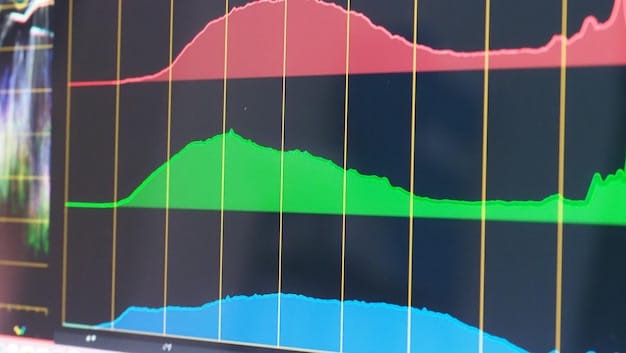US Business Confidence Index: Signals from 3-Month Drop

The recent three-month decline in the US Business Confidence Index points to growing concerns among businesses regarding inflation, supply chain disruptions, and potential economic slowdowns, suggesting a cautious outlook on future investment and hiring. This sustained dip serves as a critical indicator, signaling potential headwinds that could impact the broader economic landscape.
The latest readings from the US Business Confidence Index: What the Latest 3-Month Drop Signals for the Economy have captured the attention of economists and policymakers alike. This sustained decline, now spanning three consecutive months, raises pertinent questions about the underlying health and future trajectory of the American economy. Is it a temporary blip, or does it herald more profound shifts? Understanding the nuances of this index is crucial, as it often serves as a barometer for economic activity, reflecting the collective sentiment of businesses nationwide. This article delves into the various factors contributing to this trend, exploring what this downturn could mean for investment, employment, and the overall economic landscape in the United States.
Understanding the Business Confidence Index and Its Importance
The Business Confidence Index (BCI) is a key economic indicator that gauges the overall sentiment and expectations of businesses regarding the current and future economic conditions. It typically surveys business leaders on various aspects, including sales volume, profits, employment levels, investment plans, and general economic outlook. A higher index usually suggests optimism and a willingness to invest and expand, while a lower index indicates pessimism, potentially leading to reduced investment and hiring.
This index is significant because business sentiment often precedes actual economic activity. When businesses are confident, they are more likely to undertake new projects, increase production, and hire more staff, fostering economic growth. Conversely, a prolonged period of low confidence can lead to a slowdown in these activities, potentially signaling an impending economic contraction or recession. Therefore, monitoring the BCI provides valuable insights into the near-term future of the economy.
Key components of the BCI
Several factors contribute to the formulation of the Business Confidence Index, reflecting a multifaceted view of corporate sentiment. These components are carefully weighted to provide a comprehensive picture of how businesses perceive their operating environment and future prospects.
- Current Business Conditions: Often includes assessments of recent sales, order backlogs, and profitability.
- Future Business Expectations: Focuses on anticipated sales, production levels, and profit margins over the next six months to a year.
- Employment Outlook: Surveys businesses on their plans for hiring or laying off staff.
- Investment Plans: Indicates whether businesses intend to increase or decrease capital expenditures.
The aggregation of these elements, often across various sectors and firm sizes, allows economists to derive a composite index that offers a broad snapshot of the business mood. Changes in any of these components can significantly sway the overall index, making it imperative to analyze each element when interpreting the data.
Understanding these underlying components is vital for anyone seeking to decipher the potential implications of the index’s fluctuations. A dip driven primarily by reduced investment plans, for instance, might suggest different future outcomes than one caused solely by a perceived slowdown in current sales. Analysts often dissect the BCI’s sub-indices to gain a more granular understanding of economic trends. This detailed examination helps in distinguishing between sector-specific concerns and wider economic anxieties.
Analyzing the Latest 3-Month Drop: What the Data Reveals
The recent dip in the US Business Confidence Index over the past three months is a critical development that demands careful scrutiny. This sustained decline is not merely a statistical anomaly but reflects a growing unease within the business community. Data from various surveys, including those from organizations like the Conference Board and the National Federation of Independent Business (NFIB), indicate a consistent downward trend in sentiment across a broad spectrum of industries.
Initial analysis suggests that this three-month decline is not uniformly distributed. While larger corporations may be experiencing a moderation in their expansion plans, small and medium-sized enterprises (SMEs) often report more pronounced challenges. This disparity is crucial, as SMEs are frequently considered the backbone of job creation and economic dynamism in the US. The data points to a confluence of factors, each contributing to this pessimistic outlook, rather than a single, isolated event.
Sectoral variations and impact intensity
The impact of this declining confidence is not evenly distributed across all sectors of the US economy. While some industries might feel a moderate chill, others are experiencing a deeper freeze, underscoring the nuanced nature of economic shifts. Understanding these sectoral variations is key to a comprehensive interpretation of the BCI’s overall movement.
- Manufacturing: Often feeling the brunt of supply chain disruptions and input cost inflation, manufacturing firms show significant apprehension regarding future orders and production.
- Retail Sector: Concerns about consumer spending power and persistent inflation are weighing heavily on retail businesses, with many bracing for a potential slowdown in demand.
- Services Sector: While generally more resilient, certain sub-sectors within services, particularly those sensitive to discretionary spending, are beginning to show signs of caution in employment and expansion.
- Technology and Innovation: Interestingly, some segments within the tech sector, especially those focused on essential infrastructure or efficiency-improving solutions, may experience less severe impacts, or even counter-cyclical growth, though investment sentiment broadly remains softened.
These distinctions highlight that the overall BCI drop is an aggregate of diverse experiences. An in-depth look at specific industry reports can provide a more granular view of where the most significant pressures are accumulating. For instance, a notable drop in confidence within construction might signal a broader slowdown in real estate development, whereas a dip in hospitality could point to reduced travel and leisure spending. Tailored policy responses often depend on such detailed sectoral analyses.

Inflationary Pressures and Cost Concerns
One of the most pervasive factors contributing to the souring of business sentiment is the persistent inflationary environment. Businesses across various sectors are grappling with significantly higher input costs, ranging from raw materials and energy to transportation and labor. These increases erode profit margins and create immense pressure on pricing strategies, making it difficult for companies to maintain profitability without alienating customers.
The inability to fully pass on these increased costs to consumers, coupled with potentially softer demand, forces businesses to absorb a larger share of the burden. This squeeze on margins directly impacts confidence by reducing the perceived profitability of future investments and, in some cases, leading to a scaling back of expansion plans. The inflationary outlook, therefore, plays a pivotal role in the current pessimistic sentiment.
Impact on input costs and operational expenses
The widespread inflationary pressures are having a profound effect on the operational costs of businesses, directly influencing their bottom lines and, consequently, their confidence levels. From the initial stages of production to final delivery, nearly every facet of the supply chain is experiencing elevated expenses, making strategic planning a challenging endeavor.
- Raw Material Price Hikes: Key commodities, energy, and component parts have seen substantial price increases, directly impacting manufacturing and construction costs.
- Energy Costs: Volatile global energy markets translate into higher fuel and electricity costs, affecting logistics, production, and even office overheads.
- Labor Costs: A tight labor market, intensified by skill shortages and demands for higher wages, is pushing up compensation expenses for businesses seeking to attract and retain talent.
- Transportation and Logistics: Elevated fuel prices, shipping container shortages, and port congestion continue to drive up freight costs, making it more expensive to move goods.
These escalating input costs complicate financial forecasting and often force businesses to re-evaluate their pricing structures. While some companies have managed to pass on a portion of these costs to consumers, competitive pressures and consumer resistance limit this ability. The remaining burden directly impacts profitability, leading to a more cautious approach to future investments and hiring. The constant battle against rising expenses creates an environment of uncertainty, which understandably dampens overall business confidence, as firms struggle to project stable returns amidst fluctuating cost bases.
Supply Chain Disruptions and Capacity Constraints
Even as some aspects of global supply chains show signs of easing, many businesses in the US continue to grapple with significant disruptions and capacity constraints. The lingering effects of the pandemic, geopolitical events, and unexpected demand shifts have created a fragile logistics network. This fragility manifests as delays, unpredictable delivery times, and often, higher shipping costs, directly impairing businesses’ ability to plan and execute operations efficiently.
For manufacturers and retailers, these disruptions mean longer lead times for components and finished goods, impacting production schedules and inventory levels. For service providers, it might translate into difficulties acquiring necessary equipment or facing delays in supporting infrastructure. The inability to rely on a smooth flow of goods and services creates an undercurrent of anxiety, contributing significantly to the current downturn in business confidence. Companies are constantly forced to adapt to unforeseen bottlenecks, diverting resources and attention from strategic growth initiatives.
Consequences for production and delivery timelines
The ongoing supply chain disruptions have far-reaching consequences, particularly for production schedules and delivery timelines. Businesses, from small custom manufacturers to large multinational corporations, are finding it increasingly difficult to guarantee consistent output and timely distribution, which directly impacts customer satisfaction and overall market competitiveness.
- Production Backlogs: Delays in receiving critical components or raw materials lead to stalled production lines and growing backlogs of orders, frustrating both producers and consumers.
- Extended Lead Times: The time from order placement to goods receipt has significantly lengthened for many products, affecting inventory management and consumer availability.
- Increased Expediting Costs: Businesses often resort to more expensive air freight or expedited shipping methods to meet deadlines, inflating operational costs and reducing profit margins.
- Unpredictable Inventory Levels: The erratic nature of supply chains makes it challenging to maintain optimal inventory, leading to either stockouts that lose sales or overstocking that ties up capital.
These challenges transform routine operational planning into a daily exercise in problem-solving. Businesses become less agile and more reactive, spending valuable resources on mitigating immediate crises rather than on long-term growth and innovation. This pervasive uncertainty about when and if necessary inputs will arrive undermines the predictability essential for confident investment and expansion. Consequently, the reluctance to commit to large-scale projects or significant hiring surges is directly linked to the unreliable backdrop of current supply chain dynamics, fostering a cautious attitude among decision-makers across the economic landscape.
Impact on Investment and Employment Decisions
The three-month decline in the US Business Confidence Index directly translates into more conservative decision-making regarding investment and employment. When businesses feel uncertain about future economic conditions or face rising costs and supply chain woes, they tend to adopt a “wait and see” approach. This often means postponing major capital expenditures, such as expanding facilities, purchasing new equipment, or investing in research and development, which are crucial for long-term economic growth.
Similarly, the employment outlook becomes more guarded. Instead of actively recruiting, companies may implement hiring freezes, reduce temporary staff, or even consider layoffs if sentiment deteriorates further. While widespread job cuts may not be immediately apparent, a slowdown in hiring activity can significantly impact the labor market’s dynamism and wage growth. This cautious stance by businesses creates a feedback loop: reduced investment and slower job creation can dampen consumer confidence, further impacting demand, and thus reinforcing the initial pessimistic business outlook.
Hiring freezes and capital expenditure delays
During periods of dampened business confidence, two immediate repercussions often emerge that significantly impact the broader economy: the implementation of hiring freezes and the delay or outright cancellation of capital expenditure projects. These actions reflect a conservative approach by businesses, prioritizing cost control and financial stability over aggressive expansion, and collectively contribute to a deceleration of economic activity.
- Hiring Freezes: Rather than actively laying off existing staff, many companies first opt to suspend new hiring. This means open positions are not filled, and expansions requiring new personnel are put on hold, slowing down overall job growth.
- Reduced Replacement Hires: Even when employees leave, businesses may choose not to replace them, instead reassigning responsibilities internally, increasing workloads for existing staff, but limiting new job opportunities.
- Capital Expenditure Delays: Major investments in new machinery, technology upgrades, facility expansions, or infrastructure projects are often postponed. These “big ticket” items are typically commitments made with a long-term economic outlook, and uncertainty leads to their deferment.
- Focus on Maintenance Over Expansion: Instead of investing in growth, companies may only fund essential maintenance and repairs, preserving existing assets rather than acquiring new ones that would boost productive capacity.
These decisions have cascading effects: hiring freezes mean fewer opportunities for job seekers and potentially stagnating wages, while delayed capital expenditures stifle innovation, reduce demand for manufacturing and construction, and limit future productivity gains. The cumulative impact is a drag on economic momentum, as the engines of growth—investment and job creation—are dialed back. This cautious stance by businesses, while understandable from their individual perspective, collectively translates into a less dynamic and more stagnant economic environment.

Government Policies and Economic Outlook
Government policies play a pivotal role in shaping business confidence, and the current economic outlook is heavily influenced by how fiscal and monetary authorities respond to prevailing challenges. Businesses closely watch policy decisions related to inflation control, interest rates, tax regulations, and trade agreements, as these directly impact their operating environment and future profitability. Unclear or inconsistent policy signals can exacerbate uncertainty, further dampening sentiment, while supportive and predictable policies can help restore confidence.
Currently, the Federal Reserve’s stance on interest rates, aimed at curbing inflation, presents a double-edged sword: while necessary to stabilize prices, higher borrowing costs can deter investment. Similarly, ongoing debates around fiscal spending and potential regulatory changes add layers of complexity for businesses trying to forecast their future. The effectiveness of government interventions in addressing supply chain issues and managing inflation will be critical in reversing the current negative trend in business confidence.
The role of fiscal and monetary policy
Fiscal and monetary policies are two primary levers through which governments and central banks attempt to stabilize and stimulate the economy. In the context of declining business confidence, the efficacy and direction of these policies become even more critical, as they can either alleviate or exacerbate existing anxieties among firms.
- Monetary Policy (Federal Reserve):
- Interest Rates: The Fed’s decisions on benchmark interest rates directly influence borrowing costs for businesses. Higher rates, implemented to combat inflation, make it more expensive for companies to finance expansion or operations, potentially stifling investment.
- Quantitative Tightening: Measures to reduce the money supply can tighten credit conditions, making funds less accessible for businesses.
- Communication: Clear and consistent communication from the Fed about its intentions and outlook can provide certainty, while ambiguous signals can fuel market nervousness.
- Fiscal Policy (Government):
- Taxation: Changes in corporate tax rates or tax incentives can directly impact business profitability and encourage or discourage investment.
- Government Spending: Public sector spending on infrastructure, research, or other programs can create demand for businesses and stimulate economic activity.
- Regulation: New regulations or deregulation can affect operational costs, market entry, and competition, influencing business decisions.
The coordinated application of both fiscal and monetary policies is often necessary to effectively address economic headwinds. For instance, if the Fed is raising rates to cool inflation, targeted fiscal policies, perhaps in the form of tax credits for specific investments, might be used to counteract some of the negative impacts on business expansion. Conversely, uncoordinated or conflicting policies can send mixed signals to the market, leading to greater uncertainty. Businesses are keenly observing how these powerful tools are wielded, as their confidence in future economic stability often hinges on the perceived competence and alignment of these crucial policy frameworks. The interplay between these policies and market reactions forms a complex dynamic that significantly shapes the overall economic climate and outlook for businesses.
Looking Ahead: Potential Scenarios and Future Outlook
The three-month decline in the US Business Confidence Index, while concerning, sets the stage for several potential future scenarios for the American economy. It is paramount to consider multiple pathways, ranging from a swift recovery to a more prolonged period of sluggishness, each with its own set of implications for businesses, consumers, and policymakers. Predicting the exact trajectory is challenging, but sketching out plausible outcomes allows for better preparedness and strategic planning.
A central question remains whether this downturn in sentiment is a precursor to a mild recession or merely a mid-cycle slowdown. The answer largely depends on the persistence of inflationary pressures, the resilience of consumer spending, and the effectiveness of forthcoming monetary and fiscal policies. The outlook, therefore, remains cautiously optimistic in some corners, while others anticipate a more challenging period ahead. The next few quarters will be crucial in determining which scenario gains traction.
How businesses can navigate uncertainty
In periods of declining business confidence and economic uncertainty, proactive and adaptive strategies are paramount for businesses to not only survive but potentially thrive. Focusing on resilience, efficiency, and strategic positioning can help companies weather the storm and emerge stronger when conditions improve. This involves a multi-pronged approach that addresses both immediate challenges and long-term viability.
- Cash Flow Management: Tightening control over cash flow, optimizing working capital, and maintaining healthy liquidity reserves are crucial for navigating unpredictable economic conditions.
- Cost Optimization: Identifying areas for cost reduction without compromising quality or essential services; this might involve renegotiating contracts, streamlining operations, or adopting new technologies.
- Diversification: Exploring new markets, products, or service lines to reduce reliance on single revenue streams and mitigate risks associated with specific sectors.
- Talent Retention and Agility: Prioritizing the retention of key talent while fostering a flexible workforce that can adapt to changing demands and economic shifts.
- Innovation and Efficiency: Investing in process improvements, automation, and innovation that can boost productivity, reduce costs, and create competitive advantages in the long run.
- Strategic Partnerships: Forming alliances or joint ventures that can share risks, leverage complementary strengths, and open up new opportunities.
Furthermore, maintaining open lines of communication with stakeholders—employees, suppliers, and customers—can build trust and loyalty during turbulent times. Businesses that emphasize transparent decision-making and empathetic leadership often find greater resilience. Ultimately, navigating uncertainty requires a blend of cautious planning and an opportunistic mindset, allowing firms to adjust quickly to market shifts while keeping an eye on future growth prospects. Those that can balance financial prudence with strategic foresight are best positioned to overcome current challenges and capitalize on subsequent economic recoveries.
| Key Insight | Brief Description |
|---|---|
| 📉 Falling Confidence | US Business Confidence Index dropped for three consecutive months, signaling growing business pessimism. |
| 💰 Inflationary Pressures | Rising input costs and labor expenses are squeezing profit margins, dampening investment willingness. |
| ⛓️ Supply Chain Woes | Ongoing disruptions and capacity constraints lead to production delays and higher operational costs. |
| 🛠️ Policy Influence | Government policies on interest rates and regulation are critical to restoring business certainty and optimism. |
Frequently Asked Questions
▼
The US Business Confidence Index (BCI) measures the sentiment and expectations of business leaders regarding the economy. It reflects their views on sales, profits, employment, and investment plans, providing an early indicator of economic shifts. A healthy BCI suggests optimism, while a decline signals caution.
▼
A sustained three-month drop signifies that the decline is not just a temporary fluctuation but a more entrenched trend in business sentiment. This extended period of pessimism suggests deeper underlying concerns, potentially signaling a broader economic slowdown or even a recession, as businesses become consistently less willing to invest or expand.
▼
Inflationary pressures, such as rising costs for raw materials, energy, and labor, directly erode profit margins for businesses. This creates uncertainty about future profitability and hinders investment. When costs are unpredictable and difficult to pass on to consumers, businesses become more cautious, leading to a decline in their confidence.
▼
A sustained decline in business confidence often leads to a more cautious approach to hiring. Companies may implement hiring freezes, reduce staff turnover, or even consider layoffs if the outlook deteriorates significantly. While not always immediate, prolonged low confidence can slow job creation and increase unemployment rates, affecting the broader labor market.
▼
Businesses can adopt several strategies: focus on robust cash flow management, optimize operational costs, explore diversification into new markets or product lines, and prioritize talent retention. Investing in efficiency-boosting technologies and fostering strategic partnerships can also enhance resilience and position the company for recovery when confidence eventually returns.
Conclusion
The latest three-month decline in the US Business Confidence Index serves as a clear warning sign, reflecting a growing unease among businesses regarding the current economic landscape. This persistent dip is undeniably linked to a confluence of factors, including stubborn inflationary pressures, ongoing supply chain disruptions, and the cautious posture of both fiscal and monetary policies. While the immediate consequences may not be dramatic, the sustained downturn in sentiment suggests a tightening of corporate belts, impacting everything from new investments to hiring decisions. The coming months will be critical in determining whether this trend is merely a temporary correction or a precursor to a more significant economic slowdown. Ultimately, resilience, adaptability, and strategic foresight will be paramount for businesses navigating these challenging waters, as the interplay of economic forces continues to shape the future trajectory of the American economy.





